

Project «Voices of Jewish settlements. Vitebsk region.»פיתוח קשרי התרבות בין העמים של ישראל ובלרוס
|
|---|
Website search |
|
MainNew publicationsContactsSite mapVitebsk regionMogilev regionMinsk regionArkady Shulman
|
Travelling with Arkady ShulmanPLACE FOR MEMORIAL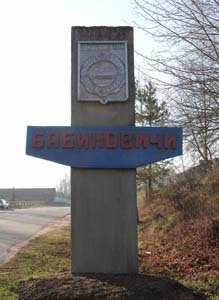 Babinovichi. Town sign post.
Babinovichi. Town sign post.
At the beginning of the Great Patriotic war Babinovichi residents had a whole month to make a decision and move westwards, as far away as possible from the Hitler’s army. The young and the strong, as well as the rich and the sagacious did that. Galina Alexandrovna Timchenko is not from here but she moved to Babinovichi right after the war together with her husband. She taught history at a local school and founded a school museum. She collected materials about the history of the place and therefore her evidence is of importance for us. “About 50 Jewish families used to live here before the war. A part of male population was mobilized, some of the people managed to evacuate.” Maria Maximovna Troyanovskaya has her personal memories: “About 60-70 local Jews were left here, plus there were people who came here from Vitebsk and other towns. Some of them brought kids here for the summer, hoping that life in small settlements would be quieter and Germans would not do them any harm.” Perhaps more people would have moved westwards, had they not listened to the Soviet propaganda, which stated we would easily and quickly defeat the enemy. Day and night people heard we were allies with the German army. When the war broke out – a lot of information about the actual state of affairs was concealed. 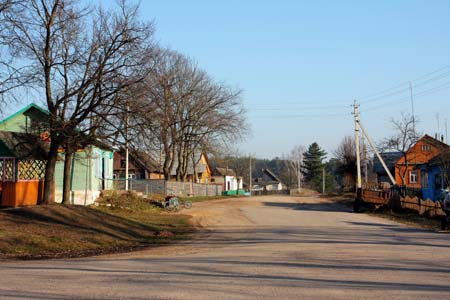 Babinovichi. Ghetto location.
Babinovichi. Ghetto location.
At the beginning of July, 1941 the Red Army moved westwards from Smolensk to Bogushevsk and passed Babinovichi. Maria Troyanovskaya remembers: “There were so many soldiers that it was impossible to cross the road.” Obviously, seeing that, people truly believed we were going to defeat the enemy fast. On June 21st the German aviation was bombing Babinovichi the whole day. The town was on fire and half of the houses were burnt down. Haya and Hanon Dvoskin died in the fire trying to carry their things out of the house. “I remembered the date, - says Maria Troyanovskaya. – It’s my birthday. The following day the Germans were in Babinovichi. Many people, whose houses had been burnt in the fire, became homeless. During the bombing we were in a village five kilometers away from the town and came back to find out our house had been burnt, too. We settled in a school together with a lot of Jews. We stayed there for a while.” Luba Semchenko’s diaryIt was approximately the end of September or beginning of October, 1941. The Nazis selected young and healthy Jewish men from Babinovichi and took them to the edge of a local cemetery. Undoubtedly they were not told they were going to be executed. Policemen knew about it and gloated: “Soon it will be over for you. You have lived enough in the Soviet era.” But people did not want to believe them. Even when the men were told to take spades they actually did believe they were being taken to work. 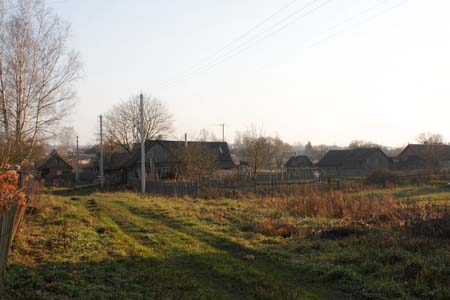 Babinovichi. Here stood the synagogue.
Babinovichi. Here stood the synagogue.
“There were 16 or 17 men, - remembers Nina Stepanovna Novikova. She was 13 in 1941. Some things she mentioned are her own memories, and others came from her parents’ and relatives’ stories. – Among them was a doctor whose last name was Ruman. The reason why I remember him is that at that moment we needed a doctor and he could not come to us anymore.” The first execution was performed by the Germans. Policemen then brought several peasants and made them fill the grave up. Even though everyone in Babinovichi knew about the execution, the peasants were also murdered as witnesses. In Babinovichi there were Jews who hid and escaped the execution. Both Nina Novikova and Maria Troyanovskaya probably remember the same person. Their stories only differ in details. A Belarusian woman from the town was married to a Jew – Mikhail Krivosheyev. He hid himself in a barn. Their house was occupied by Germans. All around Babinovichi one could see announcements: “Those who hide Jews will be shot”. Therefore Mikhail’s mother-in-law advised him to hide in the woods and search for partisans. He was hesitating for a long time, either because he was not a very brave man or because he realized what he could expect from living in the forest, especially knowing that winter was approaching. In the end, though, he left. They say, he found partisans and survived. Why did others fail to escape to the woods? What were they waiting for? – I was asked by the locals. Is it possible to leave mothers, wives and children to die? It is still a question: who was actually braver – those who were fighting with guns or those who knew they were doomed and decided not to leave their families at such tragic time? 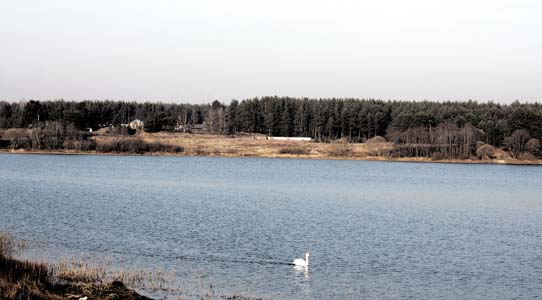 Lake Zeleninskoye. The Jews were shot on the farther side of the lake.
Lake Zeleninskoye. The Jews were shot on the farther side of the lake.
“The Pevzner sisters joined a partisan detachment, - narrates Maria Troyanovskaya. – Their names were Basia and Hana. After the war Hana visited Babinovichi. While with the partisans Basia stepped on a mine and lost both legs. They lived in a forest in a ground shelter. When the detachment had to retreat, Hana was sent away somewhere. Later she realized that she had been sent so that she would not hear the sound of a fire shot. Basia was shot – otherwise she would be a burden for the retreating detachment… After murdering the men, the rest of the Jews were all pushed into a house (or several houses located together). That was the ghetto. It was not guarded – where would the women, old people and children go? Who was prepared to give them a helping hand? Maria Troyanovskaya remembers that policemen received an order to take two or three Jewish women to Liozno but the women bribed them – they had hidden money or jewelry. Thus they returned to the Babinovichi ghetto, where their children were. It is surprising that the policemen did not just shoot the women after taking their jewelry. Perhaps they knew they would die soon anyway and decided not to take another sin. “Jews were forced to do exhausting work, they were humiliated”, - relates Galina Timchenko. Nina Novikova adds: “There was a young Jewish teacher in Babinovichi, very beautiful. We, children, saw everything. Policemen took her into a house, which is now a shop, and humiliated her in all possible ways. Then they shot her. I do not know where.” 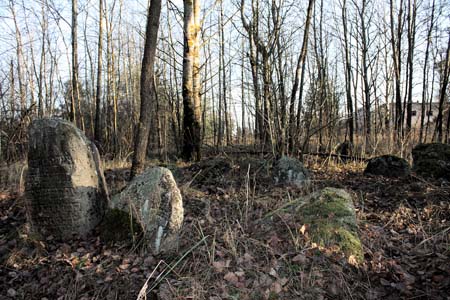 Babinovichi. Jewish cemetery.
Babinovichi. Jewish cemetery.
In the middle of February, 1942, the Germans and policemen forced the remaining Jews out of the ghetto and convoyed them across the lake to the island. Lake Zeleninskoye was frozen. It is doubtful that they dug ditches in the frozen ground – most probably they had been dug out there long before for other purposes. Policemen, who knew the neighborhood well, probably hinted the Germans where the most suitable place for the execution was. 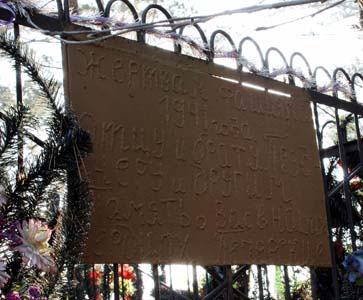 Place where Babinovichi Jews were shot.
Place where Babinovichi Jews were shot.
Nina Novikova goes on with her story: “There was a Jewish house opposite ours. Three sisters lived there: Belka, Bluma and Belita. Belka was a beautiful woman. She knitted scarves and many people bought them from her. When the Jews were being taken to the execution along our street, Belka fell into a stream. A policeman shot and wounded her. She shouted: “Help!” and when she realized no one could help she shouted: “Please, kill me!” Everyone heard that. I am not aware how many Jews were being taken to the execution but quite a few. I saw the Pevzners – I used to go to school with them, the Sheinins and others. They were taken across the lake to the island and murdered. Belka was killed in the stream.” Most probably there were other executions. Boris Cherniakov, a writer, had a dramatic story to tell. All his relatives were shot in front of him in Liozno, a settlement near Babinovichi. He survived owing to a Russian woman Feodosiya Dehtiareva. He wrote: “I saw the corpses of twenty-five Jews from Babinovichi scattered by the Germans on the road from Babinovichi to Liozno” Afroim Dvoskin, a kind man who made hats, was also killed together with his wife and daughter. Another man, Syrkin, who had been at the battlefront, arrived in Babinovichi only in 1945 to find out that his wife and four children had been killed. Mark Iosifovich Heifetz, born in Babinovichi, fought in the war and received numerous decorations. He writes: “I can remember uncle Haim and aunt Beila, 90-year-old people. They were beaten to death with guns. It was during a frosty winter in Babinovichi…” Several years ago Babinovichi residents were asked by the town council to try and recall the names of Jews murdered by the fascists. It was not a full list but we sincerely thank these people for doing it…. There is another tragic story told by people from Babinovichi. 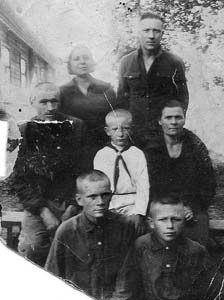 The Semchenko family.
The Semchenko family.
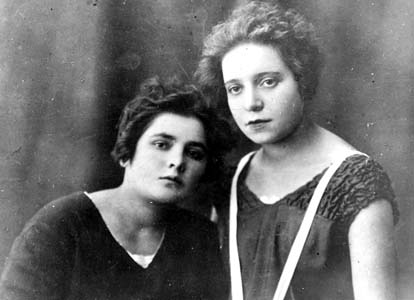 Luba Semchenko – to the right.
Luba Semchenko – to the right.
It is a story of Luba Sorkina and Arkady Semchenko, who lived in Babinovichi before the war. They were close friends and could not live a day without each other. When they grew up they got married, even though their parents did not really approve of their decision. They had two sons. At the beginning of the war Alik was a little more than 10 and the younger one, Igor, was only 1. At the beginning of the war Arkady was mobilized and sent to the battlefront. Luba was at her mother-in-law’s house in Babinovichi. She managed to get German documents – “Ausweiss” but the people in town knew who her parents were. When the ghetto was eliminated in February, 1942, Maria Troyanovskaya’s father came to their house and said: “Luba, leave the baby to your mother-in-law, I will take you and Alik to Lubavichi and you can stay there. Nobody knows you there. Your elder son does not look Jewish at all. You will survive.” Luba refused: “I will not leave the son”. On March 8th, 1942 Germans and policemen came for Luba. They took her and the small son. The elder son was near the house and as soon as he saw his mom taken away he ran up to her. Luba’s mother-in-law ran after them and begged them to let the children go. They did not let her come close. Nina Novikova recollects: “I remember Luba Semchenko and her two children were convoyed along the street by Peter Shetsky, head of policemen, and a scoundrel. I also remember the execution of two Red Army soldiers. They were wearing a uniform. They were shot. Shetsky was convicted after the war.” Luba and the children were taken to the Jewish cemetery and shot. When Babinovichi was liberated in 1943, Arkady Semchenko was informed about the death of his wife and the children. He also died in the war soon after that. Later Luba’s mother-in-law re-buried Luba and the grandsons in a civil cemetery in Babinovichi. After Luba’s death she found the young woman’s diary under her pillow. To be more exact, those were letters that Luba had written daily to her husband - about herself, the children and what was happening around. She had no opportunity to send those letters across the front line. After the war Luba’s sister came to Babinovichi and she was given that diary. Maybe one day we will be able to find and publish it. Place for memorial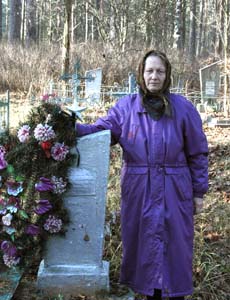 Nina Voronina.
Nina Voronina.
We headed for the civil cemetery together with Yelena Alexandrovna Makarevich, the secretary of Babinovichi town council and Nina Prokopievna Voronina. The local authorities helped us a lot on that day: we found the right people, called them and arranged to meet. During our meeting in the town council Yelena Makarevich advised: “You should talk to Nina Voronina. She is Luba Semchenko’s relative and she is the one taking care of her grave.” Nina Prokopievna brought some pre-war photos of Luba, Arkady and his parents. Arkady Stepanovich Semchenko was Nina Voronina’s uncle. We approached a neat grave, where Luba and her children were buried. Nina Prokopievna told us the following. “I was born after the war and know this story from my mother Vera Maximovna Troyanovskaya. Our family knows what war is. My father Prokop Nikolayevich Troyanovsky was at the battlefront from the very first days of the war, while mother and sister experienced all the horrors of the occupation. My mother used to take care of this grave while she was alive. I accompanied her and helped her clean up. When mom died, I started looking after the place. My granddaughter sometimes comes with me – she knows this story. One of these days she will look after Luba’s grave. Then we came up to the mass grave, where the Jewish men had been shot and buried. There is a fence and a black metal pedestal without any inscription. Still, everything is neat and clean. There are wreaths on the fence. - Is it visited by victims’ relatives? – I asked. - Last time someone came thirty years ago, - I was told. – Most probably no one is left. - But then who looks after this grave? It turned out it was Nina Prokopievna Voronina. Sometimes neighbors ask her: - Why are you doing this? They are not your relatives! She replies:  Babinovichi.
Babinovichi.
- They were people… The metal pedestal was erected by the town council in the middle of the 50s and later the victims’ relatives made a fence and attached a plate to it: “To the victims of fascism of 1941, to father and brother Pevzdner and the others. Memories of you are in our hearts. The Pecherskys.” While working on this sketch I found out that Gedalia Pechersky, who was born in Babinovichi in 1901, later lived in Leningrad. I am not sure who built the fence and made the plate on the memorial spot – Gedalia himself or his relatives. But his biography is certainly worth mentioning. During the war he was the head of the Jewish community in Leningrad. He organized removal and burial of piles of corpses lying in the synagogue in the winter of 1941-1942. In the 50s he renovated the synagogue on his own money (he worked in a dental polyclinic). He also helped the children who had lost their families in the war. At the beginning of the 70s the Pechorskys moved to Israel. In Israel a street is named after Gedalia Pechersky. …We are losing the generation of the people who remember the pre-war Babinovichi. Not a single publication ever mentioned the tragedy of the town’s Jews, there are no materials in the school or the regional museum. Even the memorial in the cemetery is nameless. The location of the mass grave with the women, old people and children is hard to find even today. Maybe at least today we should think about these people, set up a memorial near Lake Zeleninskoye and write about those who lived and died here. Babinovichi, October, 2008. |
|||
|
|
Jewish settlements in Vitebsk regionVitebsk • Albrehtovo • Babinovichi • Baran • Bayevo • Begoml • Beshenkovichi • Bocheikovo • Bogushevsk • Borkovichi • Braslav • Bychiha • Chashniki • Disna • Dobromysli • Dokshitsy • Druya • Dubrovno • Glubokoye • Gorodok • Kamen • Kohanovo • Kolyshki • Kopys • Krasnopolie • Kublichi • Lepel • Liady • Liozno • Lukoml • Luzhki • Lyntupy • Miory • Obol • Oboltsy • Orsha • Osintorf • Ostrovno • Parafianovo • Plissa • Polotsk • Prozorki • Senno • Sharkovshina • Shumilino • Sirotino • Slaveni• Smolyany • Surazh • Tolochin • Ulla • Verhnedvinsk • Vidzy • Volyntsy • Yanovichi • Yezerishe • Zhary • Ziabki • |
Main |
New publications |
Contacts |
Site map |
Vitebsk region |
Mogilev region |
Minsk region |